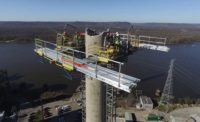U.S. Nuclear Plants Provide Market Niche for Waste Disposal System Providers

The U.S. nuclear-generation fleet's steady, predictable output of spent nuclear fuel and the federal government's inability to establish a permanent geologic repository point to several decades of regular, high-value work for contractors that install dry-cask storage systems for spent fuel.
Thanks to a government plan to establish one or more large-scale, consolidated sites for dry storage of spent fuel by the early 2020s, the next few years could be a particularly active and profitable period for the installation market, participants and others said in recent interviews.
Once the nuclear-fuel assemblies lose their ability to sustain reactions that help run plants, they are transferred to on-site spent-fuel pools for years of cooling.
With limited capacity in pools and no permanent national repository, the owners of all but a few nuclear plants already have installed on-site dry-storage systems to handle their spent-fuel overflow. There are a handful of plants without dry-storage systems, but all are planning to add them soon, said Rod McCullum, director of the used-fuels programs at the Nuclear Energy Institute (NEI).
The dry-storage systems, also known as independent spent-fuel storage installations (ISFSIs), typically consist of large, reinforced-concrete pads and rows of concrete-and-steel dry casks provided by three suppliers: Holtec International, NAC International and Transnuclear.
There are 58 existing ISFSIs in the U.S., and that number could reach 76 in a few years, McCullum said. "We've loaded over 1,600 dry casks to date, and over the next eight years we'll load 1,400 more—a steady 150 to 200 casks a year," he said. Each cask typically can handle at least dozens of spent-fuel assemblies.
The constant need for additional dry- storage capacity means a steady flow of work not only for the three cask suppliers but also for the experienced contractors that assist them in installing new ISFSIs and expanding existing ones, said Jake Hardy, senior vice president and chief commercial officer at NAES Power Contractors, based in Issaquah, Wash.
"The market has been heating up," said Hardy, both to meet new on-site storage needs and in anticipation of a planned federal pilot facility that would start receiving spent fuel from retired nuclear plants in 2021 and a larger consolidated storage facility due online by 2025.
Last year, NAES did ISFSI-related work at Exelon Corp.'s Zion plant north of Chicago. This spring it will be doing the same at Nebraska Public Power District's Cooper unit near Brownville, Neb.
NAES is lining up more ISFSI work, Hardy said. Other contractors active in the field include Joseph Jingoli & Son, Lawrenceville, N.J., and CB&I, the Woodlands, Texas-based giant that acquired The Shaw Group in February. Jingoli & Son said in a statement that it "has installed several ISFSIs concrete storage pads at nuclear generating stations in recent years in the mid-Atlantic region."
The statement said the spent-fuel storage market "seems to have a vibrant future as the government does not have a disposal site for the spent rods. Therefore, the generating stations will have to accommodate on their respective sites."

